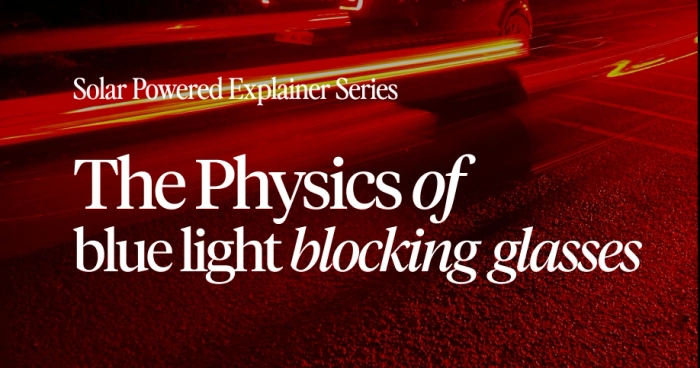In our journey through the Solar Powered Explainer Series, let’s dive into the science behind blue light blocking glasses. With artificial light becoming a staple in our daily lives, understanding how blue light impacts us and how specialized lenses work to mitigate these effects has become essential. This post breaks down the core concepts of blue light physics, its sources, and why blue light blocking glasses are effective.
What is Blue Light?
Blue light spans wavelengths from 400 to 500 nanometers (nm) and includes shades we categorize as violet, indigo, and blue. This range is part of the visible light spectrum and represents the highest-energy visible light wavelengths. The shorter the wavelength, the higher the energy, which means blue light carries significantly more energy than colors like red or yellow. This high energy is partly why blue light is both influential and potentially harmful to our eyes and sleep cycles.
Can Clear Lenses Block Blue Light?
Physics tells us that clear lenses can only partially block blue light. While some lenses marketed as "blue light blocking" can filter out portions of blue light, they do not provide complete protection. To fully block blue light, lenses would need to absorb or reflect all wavelengths in the 400–500 nm range. However, clear lenses are not designed to do this entirely. Instead, they filter out a fraction of the blue light spectrum, offering some level of protection but not enough to entirely negate exposure to high-energy blue wavelengths.
The Role of Tinted Lenses
If a lens absorbed all blue light, it would appear tinted—commonly in shades of yellow or amber. This color shift happens because removing blue light alters the balance of transmitted colors. Tinted lenses, therefore, are often used to filter a broader range of blue light, particularly within the blue-turquoise spectrum (450 to 500 nm), which has been linked to biological impacts, including eye strain and disrupted sleep patterns.
Color Balance and Blue Light Absorption
The color of the lens plays a crucial role in blue light blocking. Yellow lenses filter more blue light than clear lenses, while orange lenses go further, and red lenses provide the most robust filtering, often extending to some green light wavelengths. Red-tinted glasses, for instance, filter out nearly all blue light and part of the green spectrum, resulting in a highly effective solution for minimizing blue light exposure during evening hours or before sleep.
The Spectrum and Solar Powered Glasses
Solar Powered Glasses, a specialized design highlighted in this series, are crafted to block both blue and green light, especially up to 550 nm. By absorbing these wavelengths, the glasses reduce exposure to the most impactful light regions, helping mitigate the effects on eye health and sleep quality. With this level of filtration, Solar Powered Glasses offer comprehensive protection that’s particularly useful for those affected by extensive screen time or artificial lighting.
Natural Blue Light and the Sun
It’s essential to remember that the sun emits a full spectrum of visible light naturally, including all colors from red to violet. Within this spectrum, blue light represents only a part, specifically from violet to blue. Unlike artificial sources, sunlight is balanced with a mix of wavelengths, including red and orange, which help counteract the potential negative effects of blue light. This natural balance contrasts with the intense, unbalanced blue light from screens and LED lights, making artificial blue light more disruptive, especially during evening hours.
Conclusion
Blue light blocking glasses serve a crucial purpose by filtering harmful blue wavelengths from artificial sources. While clear lenses offer partial protection, tinted lenses—yellow, orange, or red—provide more effective filtering by absorbing broader sections of the blue spectrum. Solar Powered Glasses, with their advanced red tint design, go further to block both blue and green light, offering robust protection for those heavily exposed to screens or artificial lighting. Understanding the physics of blue light and how lenses interact with these wavelengths empowers us to make informed choices for our eye health and overall well-being.


